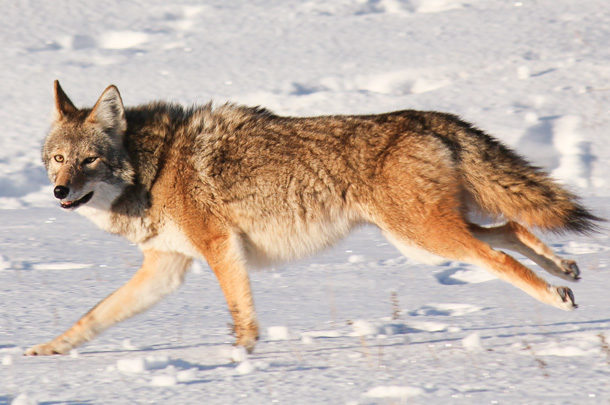Cattle producers are no stranger to the stress coyotes wreak on their herd and pocketbook. Deciding what type of control to use – and when to implement it – is critical to preventing the long-term health and financial repercussions coyotes are capable of inflicting.
With spring calving season in full swing, coyotes will continue to be a main cause for concern on cow-calf operations across the country. According to the 2015 USDA Death Loss in U.S. Cattle and Calves Due to Predator and Nonpredator Causes report, 40.5% of all cattle deaths and 53.1% of all calf deaths due to predators were caused by coyotes. Among cattle producers, there seems to be a general consensus: Coyotes are a nuisance, detrimental to newborn calves and difficult to control.
Fighting biology
The idea that backed the childhood game Whack-A-Mole – where knocking out one mole somehow seemed to make 10 more appear – is the same logic that drives coyote reproduction when the population is under pressure.
“Coyotes have this mechanism, this population regulation mechanism called compensatory natality,” says Drew Ricketts, assistant professor and extension wildlife specialist at Kansas State University. “Basically, what that means is: They’re able to adjust the birth rate to compensate for fluctuations in their population.”
According to Ricketts, the average size of a coyote litter is three to four pups. After big population control efforts, such as the use of fixed-wing aircraft, trapping or shooting, the compensatory natality mechanism causes the average litter size to double. Additionally, in most breeding seasons, the female pups born the spring before will typically not breed. Competition for territories is low after attempts to scale down the population, meaning female yearlings will have more resources, a mate and territory – and therefore, increasing the likelihood of them breeding early.
This means cattle producers are not only fighting increasing numbers; they are fighting biology. The problem, however, is twofold.
“About half of the coyotes in a given population will be residents, and those residents are breeding pairs,” Ricketts says. “The other half of the population is what we call transients, which are individuals that don’t really have a territory – they’re sort of nomadic and floating, waiting for a resident to die so they can fill that territory.”
According to the USDA Wildlife Services annual Program Data Report, 62,700 coyotes were lethally removed in 2020. Though this mass removal was most likely needed to scale down the population, it also created additional ease of access for transient coyotes to take the place of residential members in a pack, replacing breeding pairs that might have been eradicated. Ricketts explains this dynamic, coupled with the compensatory natality component, is what makes coyote population control so difficult, and producers are better off targeting problem individuals as they arise.
Managing your herd
While it is reasonable to blame a coyote for a calf’s death, oftentimes prevention begins within the cow herd. Keeping a close eye on first-calf heifers and observing how well or how poorly they protect their calves under threat can make culling an easier job.
“Managing the coyote itself and managing your herd goes hand in hand,” says John Tomecek, associate professor and extension wildlife specialist at Texas A&M University. “From a cattleman’s perspective, you want to have a really tight calving window with those calves in an easy-to-check area. If you do have those moms that are bad about abandoning calves or pushing them off, then they need to go – because when she’s older, she’s going to teach the younger ones.”
Every cow would calve in an easily accessed pasture and within a handful of days, in an ideal world. In reality, cattlemen operating on a larger scale and with more head to manage must be able to rely on their cows’ natural instincts to keep their calves alive. The first 24 to 48 hours is when calves are most susceptible to being attacked by a coyote – the time period when a cow should also be most attentive. With the average coyote only weighing 25 to 40 pounds, a protective mother cow should be more than capable of defending her newborn during those critical first few days post-calving.
Management strategies such as selecting for maternal, protective cows only go so far when the number of landowners engaged in agriculture is declining. Operation size is also a factor in the degree of control producers can inflict just on their land alone.
“There’s fewer and fewer people [who] care about coyote control, so that definitely changes the dynamic,” Tomecek says. “Let’s say I raise cattle, but I have a neighbor who doesn’t care at all about livestock. I might be having problems with coyotes that are actually living on the neighbors’, but they’re killing on my property, and there’s only so much I can do about it.”
So what is the most effective method for controlling coyotes?
“When I start having problems, I go ahead and put some control right there on that specific coyote,” Tomecek says. “I’m going to look at my toolkit and see what methods make the most sense.”
Control in action
For Ryan Boedeker, co-owner of MC Boedeker Ranch in Shiner, Texas, calling and shooting is the most effective method in his toolkit for keeping coyotes at bay on their commercial Brangus cow-calf operation.
“Coyotes have negatively impacted both our cattle herds and deer populations on our ranches in the years we have been more lax about our control,” Boedeker says. “We have seen our fawn crop decline significantly when survival rates should have increased, given sufficient rainfall and supplemented feed.”
Boedeker says as far as their cattle operations are concerned, they have recently observed coyotes chasing calves during the day.
“Coyotes usually do most of their hunting and scavenging at night,” Boedeker says. “When we have more sightings of them during the day, this indicates an overpopulation that is having to compete for food sources. When this occurs, we know it is time to implement some targeted control to keep the numbers in check and help protect our cattle and wildlife.”
Cattle producers have a variety of methods available at their disposal to select from when control is necessary, depending on their state’s regulations. Snares and foothold traps, calling and shooting, trapping, toxicants, aerial shooting or working with the USDA Wildlife Services are some options to consider based on time, location, operation scale and the severity of predation.








